Are you a Quiet Speculation member?
If not, now is a perfect time to join up! Our powerful tools, breaking-news analysis, and exclusive Discord channel will make sure you stay up to date and ahead of the curve.
A week ago, if you asked anyone down on the street what the most dangerous deck in Modern was, two times out of ten you would get “Grixis Death’s Shadow” as your answer. The other eight would have no idea what you were talking about, and point you in the general direction of the nearest psych facility. You may agree or not. But after just one weekend of dominant play at Star City Games Charlotte, the Magic community collectively decided that Grixis Death’s Shadow was an oppressor that needed to be eradicated.
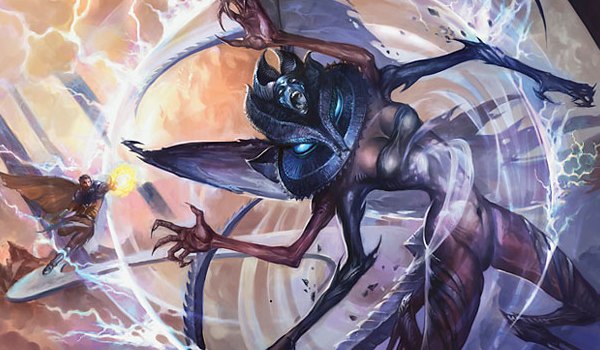
Now Grand Prix Vegas results are in, and the world has delivered its verdict: Grixis Death’s Shadow will be stopped at all costs. Today, we’ll be taking a look into the weekend’s results, and diving specifically into the psychology behind what inspires a community to "target" a deck. Let’s dive in.
Part One: GP Vegas by the Numbers
We’ll start with Grixis Death’s Shadow. No copies in the Top 8, two copies in the Top 16, four more in the Top 32. We’ve seen results like these before, so it’s not a stretch to infer that Grixis Death’s Shadow was a popular deck capable of putting up strong results that was inevitably brought down by a hostile field. Log this away—we’ll get back to it later when we start digging into lists. The second-biggest story, of course, is three copies of Affinity in the Top 4, with one taking home the trophy. I say second-biggest because if there’s any deck that could put up results like this without anyone batting an eye, it’s Affinity. Again, more on this later. Finally, even more perplexing is the absence of Dredge and Storm, replaced by Burn, Hatebears, and Taking Turns at the top tables. There’s a ton of information to break down here, so let’s start at the top.
Where Is Grixis?
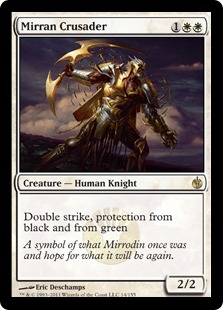 At SCG Charlotte, Grixis Death’s Shadow players trimmed Lightning Bolt in an attempt to gain an edge in the mirror, and to help poor matchups like Eldrazi Tron. By doing so they opened up a weakness that previously was protected by Eldrazi Tron (it’s complicated) wherein small creature decks could capitalize assuming they could deal with Thought-Knot Seer. Enter Mirran Crusader. In a Lightning Bolt format, Mirran Crusader is beyond embarrassing, worse even than Geist of Saint Traft in a format full of blockers. Unfortunately for Grixis Death’s Shadow, the deck became too inbred, focusing on beating itself and fighting a myriad of hate from all angles of the format. It pushed itself too far down one end of the spectrum, until it found itself losing in areas that could have been easily protected.
At SCG Charlotte, Grixis Death’s Shadow players trimmed Lightning Bolt in an attempt to gain an edge in the mirror, and to help poor matchups like Eldrazi Tron. By doing so they opened up a weakness that previously was protected by Eldrazi Tron (it’s complicated) wherein small creature decks could capitalize assuming they could deal with Thought-Knot Seer. Enter Mirran Crusader. In a Lightning Bolt format, Mirran Crusader is beyond embarrassing, worse even than Geist of Saint Traft in a format full of blockers. Unfortunately for Grixis Death’s Shadow, the deck became too inbred, focusing on beating itself and fighting a myriad of hate from all angles of the format. It pushed itself too far down one end of the spectrum, until it found itself losing in areas that could have been easily protected.
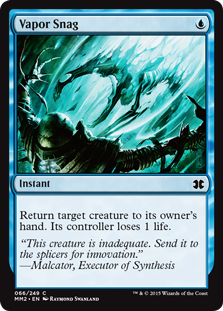 Relic of Progenitus. Grafdigger's Cage. Dispatch. Vapor Snag. Rest in Peace. Affinity has no shortage of sideboard options to fight Grixis Death’s Shadow, but it can’t do it all itself. Ceremonious Rejection on top of Kolaghan's Command is too good, but with a little bit of help from the other decks in the format, Affinity can find itself brought back to relative parity. Grixis Death’s Shadow still probably wins the matchup, but in the end, that didn’t really matter. The field chose to attack Grixis Death’s Shadow, and by doing so, they ignored Affinity and removed one of the plugs holding it from flooding the metagame. Hence, three copies in the Top 4.
Relic of Progenitus. Grafdigger's Cage. Dispatch. Vapor Snag. Rest in Peace. Affinity has no shortage of sideboard options to fight Grixis Death’s Shadow, but it can’t do it all itself. Ceremonious Rejection on top of Kolaghan's Command is too good, but with a little bit of help from the other decks in the format, Affinity can find itself brought back to relative parity. Grixis Death’s Shadow still probably wins the matchup, but in the end, that didn’t really matter. The field chose to attack Grixis Death’s Shadow, and by doing so, they ignored Affinity and removed one of the plugs holding it from flooding the metagame. Hence, three copies in the Top 4.
Hatebears
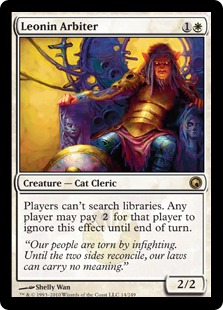 The new kid on the block this week wasn’t Counters Company, as some predicted, but Hatebears. Counters Company thrives in a Lightning Bolt-less format, but Fatal Push is just as effective against it. While it has methods of its own to fight Eldrazi Tron (the real format oppressor) Counters Company can’t claim the same level of resilience against Tron that Hatebears can. Leonin Arbiter and Ghost Quarter is nothing new, but it doesn’t need to be. If it ain't broke, don’t fix it, as someone said. Weathered Wayfarer is also old tech, but it shows that Eldrazi Tron is foremost in Hatebears’ mind as an archetype to target.
The new kid on the block this week wasn’t Counters Company, as some predicted, but Hatebears. Counters Company thrives in a Lightning Bolt-less format, but Fatal Push is just as effective against it. While it has methods of its own to fight Eldrazi Tron (the real format oppressor) Counters Company can’t claim the same level of resilience against Tron that Hatebears can. Leonin Arbiter and Ghost Quarter is nothing new, but it doesn’t need to be. If it ain't broke, don’t fix it, as someone said. Weathered Wayfarer is also old tech, but it shows that Eldrazi Tron is foremost in Hatebears’ mind as an archetype to target.
Untitled Deck
Hatebears gets a lot of hate (heh) and for good reason, but it’s hard to argue with what the archetype is bringing to the table right now. Grixis Death’s Shadow does some pretty unfair things, of course, but it can be attacked in fairly straightforward ways. Before, players tried to fight Grixis on one axis, be it their graveyard or their board, but Death’s Shadow has shown that it’s strong enough to fight back against half-hearted hate. Stubborn Denial and Thoughtseize are incredible cards for helping Grixis through any sticky situation, but under dedicated hate, the deck can’t hope to succeed for long. Sure, they’ll take a match here and there through multiple Path to Exile and Relic of Progenitus, but when every single opponent, match after match, is prepared to fight both their board and their graveyard, Grixis Death’s Shadow is going to fall eventually.
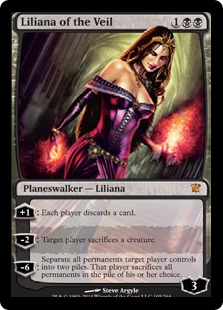 I saw this coming last week, which is why I made moves to shift away from creatures and the graveyard towards planeswalkers and card advantage. Whether these sorts of moves will keep Grixis in the hunt is yet to be seen, but even if players make these changes en masse, the deck can’t hope to survive while it’s facing archetypes primed to beat it like Hatebears. Hatebears as it is built currently can present a proactive gameplan against the field at large, while bringing specific cards to bear in problematic matchups. Blade Splicer into Restoration Angel isn’t blowing the socks off of anyone in 2017, but as long as Relic of Progenitus can slow down multiple archetypes a significant number of turns it seems that’s all it takes. Burrenton Forge-Tender for Burn and Anger of the Gods; Thalia, Guardian of Thraben for spells; Relic of Progenitus for the graveyard—on and on it goes. The format is polarized at this point, and the enemies are known.
I saw this coming last week, which is why I made moves to shift away from creatures and the graveyard towards planeswalkers and card advantage. Whether these sorts of moves will keep Grixis in the hunt is yet to be seen, but even if players make these changes en masse, the deck can’t hope to survive while it’s facing archetypes primed to beat it like Hatebears. Hatebears as it is built currently can present a proactive gameplan against the field at large, while bringing specific cards to bear in problematic matchups. Blade Splicer into Restoration Angel isn’t blowing the socks off of anyone in 2017, but as long as Relic of Progenitus can slow down multiple archetypes a significant number of turns it seems that’s all it takes. Burrenton Forge-Tender for Burn and Anger of the Gods; Thalia, Guardian of Thraben for spells; Relic of Progenitus for the graveyard—on and on it goes. The format is polarized at this point, and the enemies are known.
Part Two: Public Enemy Number One?
Grixis Death’s Shadow has nobody to blame but itself. Or does it? While it’s true that they opened themselves to getting destroyed by Mirran Crusader, it can be argued that the format-wide pushback to a deck that is debatably fair is an over-reaction, or at least premature. Yes, it feels bad to get hit by a 10/10 Death's Shadow that was cast for one mana, but alongside Affinity, Dredge, and Storm, is that really “too crazy” for Modern? Dredge can flood the board with creatures on turn three (or two), and Conflagrate our board or our life total for 8+ damage. Affinity dumps its hand on the second turn, and Storm can combo out on turn two or turn 10. Are Thought Scour, Kolaghan's Command, and undercosted 5/5’s really worth freaking out about?
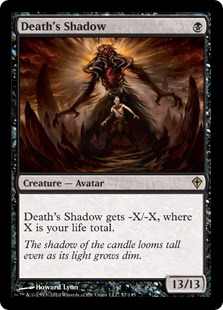 Apparently, yes. See, Grixis Death’s Shadow is a machine, and nobody likes machines. They rage against them, even. I testify that it doesn’t matter how many copies Affinity puts into the Top 4 of events, players will refuse to wake up to the truth; they are biased against value decks. It feels worse to lose to Grixis Death’s Shadow because games take longer, because they play Thoughtseize, because they “always have the Stubborn Denial,” because it isn’t fair to play a 4/5 on turn two, or a 2/2 that grows quickly on turn three. Apparently, it’s much more fair to lose to Cranial Plating on a lifelinked, flying Vault Skirge attacking for seven on turn two, or the one-card combo Cathartic Reunion turning over a ton of value into the graveyard. Why is this?
Apparently, yes. See, Grixis Death’s Shadow is a machine, and nobody likes machines. They rage against them, even. I testify that it doesn’t matter how many copies Affinity puts into the Top 4 of events, players will refuse to wake up to the truth; they are biased against value decks. It feels worse to lose to Grixis Death’s Shadow because games take longer, because they play Thoughtseize, because they “always have the Stubborn Denial,” because it isn’t fair to play a 4/5 on turn two, or a 2/2 that grows quickly on turn three. Apparently, it’s much more fair to lose to Cranial Plating on a lifelinked, flying Vault Skirge attacking for seven on turn two, or the one-card combo Cathartic Reunion turning over a ton of value into the graveyard. Why is this?
It all comes down to psychology, and human emotion. See, we like to say that we’re analytical and unbiased, capable of making decisions based on evidence alone. But in the end, the biggest driving force behind our opinions is emotion. And no matter what you think, everyone can agree that for some reason it just feels worse losing to Grixis Death’s Shadow than it does to Affinity. We all know why, but we don’t think about it consciously. Everyone knows they’re going to lose to Affinity game one, and they don’t mind, as they know they can destroy Affinity in post-board games with Stony Silence. We’re sheep, gladly giving in to an archetype that does incredibly unfair things because we have in our possession that magic bullet that can solve all our problems. We don’t care, and neither do Affinity players, because they are smarter than us, and they know that eventually, our memories will fail us, and we’ll move on to other perceived threats, leaving them to do what they do, in an endless cycle.
Grixis Death's Shadow, on the other hand, is too resilient, and less all-in, to be destroyed in one fell swoop by a sideboard bomb. It feels worse when they reload from your Relic of Progenitus, because the deck is built that way on purpose. Still, it seems like the deck is overpowered because it's able to shrug off one copy of a sideboard spell, and as Magic players, we've become conditioned to believe that our sideboard spells are all bangers. There was a time when every deck in the format had to slow down, play fair, do their part, and find some room for Dismember. I'm not saying that's where we are, but before placing all the blame on Death's Shadow, maybe we should look to playing interactive Magic first. Maybe that's a bad idea, but I'd rather try it and say it didn't work than not try at all.
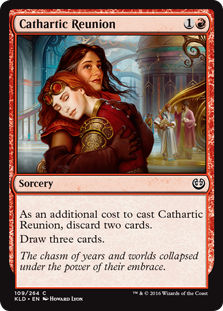 Dredge doesn’t care if you ban its Dredge 6 value piece. There’s plenty more where that came from. Bloodghast, Narcomoeba, Prized Amalgam, Cathartic Reunion, Life from the Loam, hell, even Conflagrate would have been better ban decisions, but here we are. No, the biggest enemy is Grixis Death’s Shadow, because it dares to play Thought Scour and trade a bad Burn matchup for a powerful creature to use against everyone else.
Dredge doesn’t care if you ban its Dredge 6 value piece. There’s plenty more where that came from. Bloodghast, Narcomoeba, Prized Amalgam, Cathartic Reunion, Life from the Loam, hell, even Conflagrate would have been better ban decisions, but here we are. No, the biggest enemy is Grixis Death’s Shadow, because it dares to play Thought Scour and trade a bad Burn matchup for a powerful creature to use against everyone else.
Conclusion
See, I know myself enough, and I’m honest enough with myself to realize that my position on this is coming from a perspective influenced by emotion. I am what I am, and what I am is a middle class, Southern, white male that loves casting blue spells. Naturally, this makes me the enemy, and means my perspective is flawed, but I digress. I hope this doesn’t come across as a whining piece lamenting the unfair bullies of the format that won’t let me enjoy my sweet Grixis limelight for just a week before they rip it away from me. Sure, that’s part of it, but really, I’m more perplexed by the overreaction of everyone else than anything.
I’ll continue to attempt to approach the format in interesting ways, and I hope you do the same. For those looking for hot takes, Jeskai Control is bringing the heat right now. So sleep now in the fire, and I’ll see you later this week.
Thanks for reading,
Trevor Holmes




I can do nothing but agree with the contents of this article. I think death’s shadow, believe it or not, created a very healthy modern metagame. I don’t think any action towards the deck is needed. If something, I think the format is in such an healthy spot that un unban might be in order.
Your last article: This deck is busted, Grixis Shadow is by far the best deck in Modern!
This article: Why is everyone hating so irrationally hard on DS Grixis?!?
I think you should reread your last month+ of articles on this subject, ideally with someone else helping to identify where your own biases and ego are hampering your analysis and your writing.
You predicted that the best deck in the format would do well, then it did and you bragged about it in your next article (akin to me bragging about predicting that the Warriors would win the title). This led you to overstate just how good the deck actually was, calling it dominant and writing off evidence to the contrary (didn’t show up in the Classic because it’s pilots were all in day 2? Seriously?). Your bias also led you to misinterpret your own tournament performance, in a way that came off as extremely arrogant. Now your pet deck, which happens to be the best deck in the format, gets targeted by some hate (predictably) and we get some pseudo-psychology about how the hate is irrationally driven by the deck being less fun to lose too (something many people would NOT agree with).
I think you could write some useful content if you were able to drop some of the ego/bias driven stuff and focus more on actually helping the reader than validating your opinions. Instead of just making predictions why not give more concrete advice related to those predictions? “Decks X, Y, Z are poised to surge next week so you should be looking to do…”.
Of course to a degree this kind of analysis is limited in its usefulness in Modern due to the sheer diversity in the format. Dredge upticking from 5% of the meta to 8% is a big jump…but not actually going to have that big of an impact on how often I face the deck in a given league/tourney. With that in mind I think an extremely useful analytical take along the lines you are good at would involve grouping/sorting multiple decks by angles of attack or cards that they are soft to. Maybe Dredge going up a few % isn’t a big deal, but it it is rising along with 2 other decks that are weak to Gradiggers Cage now we have some actionable intelligence. Along the same lines you could keep track of the meta shares of decks that are softer to Path/Push/Bolt/Decay/etc, helping people to know which types of removal will likely be optimal that week. Are decks that are soft to sweepers on the uptick? Anyway, just a suggestion for how you could convert your predictions (something I think you are good at) into more useful information for the reader.
I understand your opinion but do not share it. I am local player playing BW tokens for years now, tuning my deck with each new set. Currently I love matchups against death’s shadow variants. Having access to 3 leyline of sanctity, survival extraction, flying tokens, 7 discard spells and 7 spot removal plus engineered explosives and 2 auriok champions, matchup is one of easiest. What i hate je to play my fair midrange deck against degenarate unfair combo decks. This is real unfun for me.
Truth is that when I watch coverage of big events showing DS match after match, I root against DS always. Even ad nauseum je better. The main reasons is I really hate bandwagoning. Watching top pros with ton of experience sleeving “best deck” is painful and for me shameful as well. This is the reasons aby i have so much respect for Craig wescoe (loyal to white whinnie strategies) od Zach elsik (innovation, it was pleasure to see him playing deep blue Tech – beat it pros!).